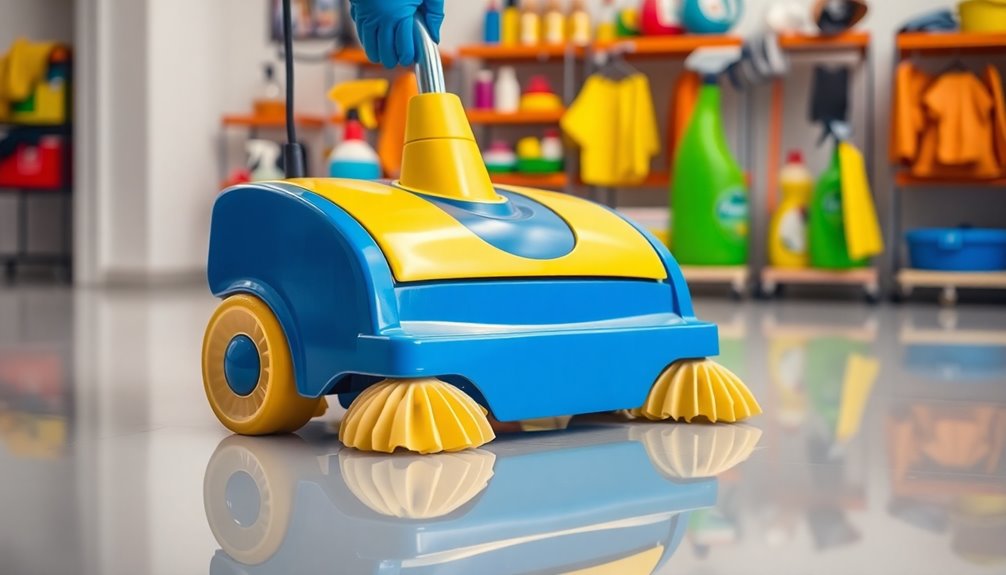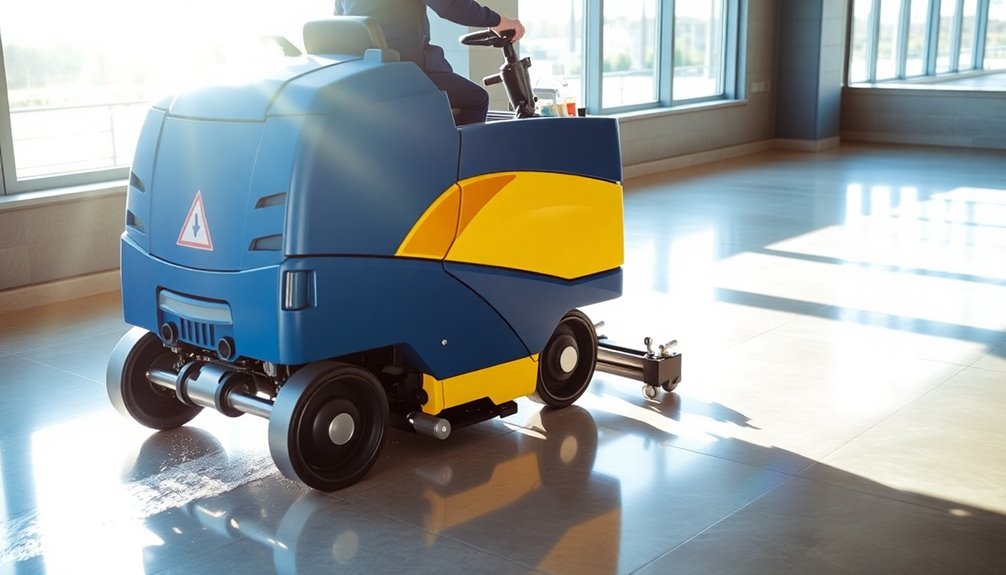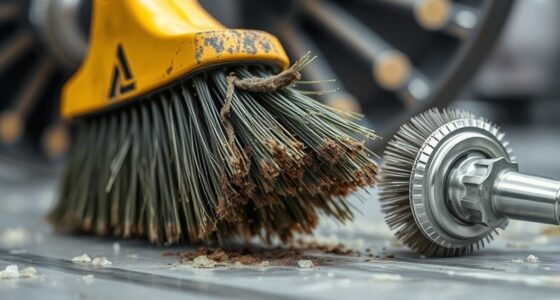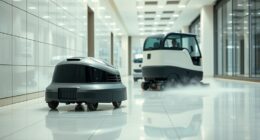To operate a floor scrubber, start by prepping the area—remove debris and damp mop the floor. Then, fill the solution tank with water and detergent, following the manufacturer's instructions. Begin scrubbing from the farthest corner using straight, overlapping rows for even coverage. Keep an eye on the recovery tank and empty it when needed to maintain suction. Finally, clean the tanks and store the scrubber properly. There's more to ensuring effective cleaning, so keep going!
Key Takeaways
- Prepare the area by removing debris and damp mopping to enhance cleaning efficiency.
- Fill the solution tank with water and detergent, following manufacturer instructions for proper mixing.
- Begin scrubbing from the farthest corner, using straight rows and overlapping passes for even coverage.
- Monitor the recovery tank level during operation and empty it as needed to maintain suction performance.
- Clean and dry both tanks thoroughly after use, and store the scrubber in a safe area to prolong its lifespan.

Operating a floor scrubber can seem daunting at first, but it's straightforward once you know the steps. Before you start, it's essential to prepare the area. Begin by removing any loose debris from the floor and ensure it's dust mopped and damp mopped. This prep work ensures your cleaning equipment works effectively and efficiently.
Once your floor's ready, fill the solution tank with water and detergent based on the manufacturer's specifications. Remember to add water first; this helps minimize foaming and ensures that your commercial floor scrubber operates smoothly.
With the solution ready, you can move on to the actual scrubbing process. Start from the corner of the room that's furthest from the exit. This way, you won't walk over the clean floor. Work in straight, parallel rows, making sure to slightly overlap each pass to achieve even coverage. The scrub path is crucial; it ensures you don't miss any spots on the industrial floor. Whether you're using a pad or brush, keep the scrubber moving back and forth for consistent results.
As you scrub, keep an eye on the recovery tank level. It's essential to monitor it during operation and empty it as needed. If the recovery tank overflows, it can compromise the suction efficiency of your floor scrubber, making your cleaning less effective.
After your scrubbing session, don't forget the cleanup. Both the solution and recovery tanks need thorough cleaning. This step is vital for maintaining the longevity and optimal performance of your cleaning equipment. If you skip this, you might run into clogs or other issues next time you use it.
Finally, store the scrubber properly. Make sure it's in a designated area where it won't get damaged, and ensure all components are dry to prevent mildew. Proper storage not only prolongs the life of your industrial floor scrubber but also ensures it's ready for your next cleaning job.
Frequently Asked Questions
How Do You Control a Floor Scrubber?
To control a floor scrubber, you start by ensuring it hovers in place when you power it on.
Make subtle handle adjustments for side-to-side movement, allowing you to navigate easily.
For forward and backward motion, simply step in the desired direction while keeping control.
Overlap your passes to cover the entire floor evenly, and if you encounter tough spots, twist the handle to apply extra pressure for a targeted clean.
How Do You Use a Floor Scrubber Ride?
When you first hop on a ride-on floor scrubber, it feels like stepping into a cleaning adventure.
You'll want to remove any loose debris from the floor to kick things off right. Fill the solution tank with the right mixture, then start in the farthest corner, working your way out in neat, overlapping rows.
Keep an eye on the recovery tank and recharge your scrubber after use to keep it in top shape.
How Does a Walk Behind Floor Scrubber Work?
A walk-behind floor scrubber works by combining a water solution with a scrubbing pad or brush that rotates rapidly.
You guide the machine manually, giving you control in tight areas. It has a solution tank that mixes water and detergent, which is dispensed onto the floor while cleaning.
The dirty water is then collected in a recovery tank. You can also adjust the brush pressure to suit different floor types and soiling levels.
Do You Need a License to Operate a Floor Scrubber?
You don't typically need a specific license to operate a floor scrubber, but training is crucial.
Your employer might provide in-house training or require certification to ensure you understand safety protocols and equipment use.
It's essential to check your workplace policies and any local regulations, as some places may have stricter requirements.
Proper training not only keeps you safe but also boosts cleaning efficiency and extends the life of the equipment.
Conclusion
In conclusion, mastering the operation of a floor scrubber not only makes your cleaning tasks easier but also boosts efficiency. Did you know that using a floor scrubber can reduce cleaning time by up to 75% compared to traditional mopping methods? With the right techniques, you'll achieve spotless floors in no time, saving you both effort and energy. So, grab your scrubber, and see how quickly you can transform your space into a pristine environment!









